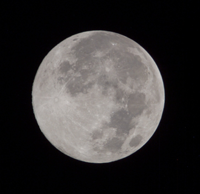When the Moon Is Full (Or Seems to Be)
Last month's interest in goblins and ghouls has faded, but you can spice up November classroom and family science discussions with a blend of astronomy and a fitting 'trick' of the eye in preparation for this month's full moon!

From astronomy projects to tests of human perception, the changing faces of the moon invites student science exploration.
Students curious about the full moon illusion can learn more about afterimages in the "Are Your Eyes Playing Tricks on You? Discover the Science Behind Afterimages!" Project Idea. For classroom exploration, the "Discovering the Colors Behind Afterimages" classroom activity guides teachers in preparing a fun, short, hands-on science project.
The Night Sky
How bright is the moon when it is full? How much does the moon's brightness vary during its different phases? As November's moon cycles through the phases, these are questions young astronomers can put to the test! The "Measuring the Moon" astronomy Project Idea guides students in observing the moon throughout the month and recording light meter readings. Using this data, students can make correlations between phases of the moon and its brightness.
Lunar Illusion
The "Measuring the Moon" project helps encourage students to gather and synthesize firsthand data to learn more about the moon. The "I See a Full Moon Rising...and Shrinking...or Do I?" Project Idea, on the other hand, prompts an exploration of the way we perceive the moon as it appears to climb into the night sky. This Health & Human Biology Project Idea helps students investigate the way the brain miscalculates the size of the moon in different locations, a trick of the mind which leads to the full moon illusion. In this project, students learn more about afterimages and Emmert's law. With a series of hands-on tests, students can put Emmert's law in motion as they investigate how the perceived size of an afterimage changes in relation to one's distance from the viewing surface.
Making Connections
Just weeks after Hurricane Sandy, the after-effects of the monstrous tropical storm that swept across Eastern states are still making headline news. While many things contributed to the storm's ferocity, the storm also approached land during a full moon. Which phase of the moon has the most powerful effect on tidal patterns? Using historical data, your students can find out in the "The Moon and Tides" astronomy Project Idea. For other suggestions for student science projects related to Hurricane Sandy, see the "Frankenstorm Science: Hurricane Sandy" blog post.
Science Buddies Project Ideas in Astronomy are sponsored by Northrop Grumman.
Science Buddies Project Ideas in Human Biology & Health are sponsored by the Medtronic Foundation.
Categories:
You Might Also Enjoy These Related Posts:
- Plastics and Earth Day - Science Projects
- Arduino Science Projects and Physical Computing
- 10+ Robotics Projects with the BlueBot Kit
- 5 STEM Activities with Marshmallow Peeps
- March Madness Basketball Science Projects: Sports Science Experiments
- Women in STEM! More than 60 Scientists and Engineers for Women's History Month
- Explore Artificial Intelligence and Machine Learning with Student AI Projects
- 10 Reasons to Do the Rubber Band Car Engineering Challenge









